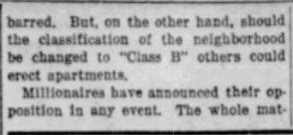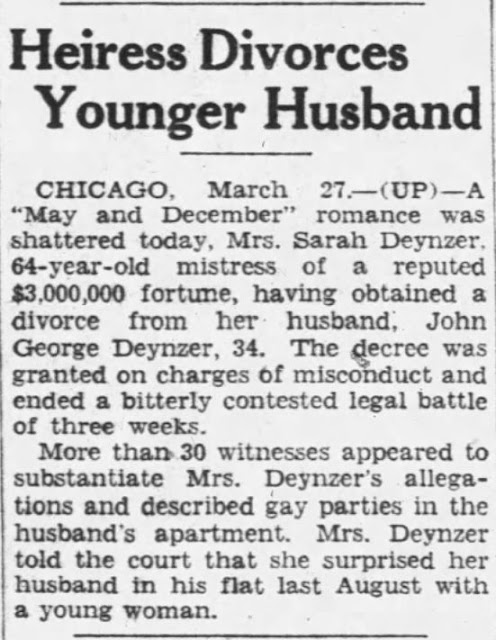If you have not already read Part One of this tale, you should read it before reading Part Two:
https://undereverytombstone.blogspot.com/2022/04/evanstons-richest-woman-68-elopes-with.html
Part One tells the story of the first marriage of Sarah Vowell. In 1885 Sarah (Sadie) Vowell married Renaissance man Edwin F. Brown. Although they spent the last five years of their marriage apart, there was a death-bed reconciliation just before Brown's death on February 15, 1912. With a Last Will and Testament executed just two days before he died, Edwin Brown left his widow $3 million ($87.7 million today).
I ended Part One with the query "What did Sarah do with her sizable inheritance?" This month we will find out.
At the beginning of her widowhood, Sarah Vowell Brown did not change her lifestyle much at all. She remained in the cadmium-yellow main house of her lakefront estate "Windiknowe", although she did have Edwin Brown's barge the "Driftwood" pulled to shore and placed on Sheridan Road just south of the Evanston lighthouse. Sarah then had the barge turned into a honeymoon cottage for her daughter Lucille and Lucille's first husband Ira Jay Ingraham after their marriage on June 12, 1912.
History tells us that 57 year old Sarah Vowell Brown met 25 year old John George "Jack" Deynzer of Bloomington, Illinois when he called on her to sell her some oil stocks. After a "whirlwind" twenty-four day courtship, they were married March 18, 1921 at Windiknowe. Here's how Deynzer's home town newspaper (The Bloomington (IL) Pantagraph) reported it in their edition of March 23, 1921:

Before we look into their marital bliss, let's see what we can "dig up" about Jack Deynzer.
John George Deynzer was born May 20, 1896 in Bloomington, Illinois, the son of Oscar M. Deynzer (1904-1939) and Anna Bayer (1868-1942). Jack Denyzer was the third of eight children born to Oscar and Anna. The offspring were: Lucy/Mrs. Roy Schifflet (1891-1960), Bertha/Mrs. Edward McKern (1892-1979), Jack (1896-1983), Flora/Mrs. Gilbert Perry (1901-1987), Oscar (1902-1939), Malvin (1907-1972), Orville (1910-1970) and Josephine (1914- ????). Oscar Deynzer was a blacksmith by trade. The family homestead was at 1312 W. Chestnut in Bloomington, Illinois.
 |
| 1312 W. Chestnut, Bloomington, Illinois |
The 1913 City Directory for Bloomington, Illinois shows seventeen year old Jack living at the family homestead, and working as a "Porter" for Humphreys & Co., wholesale grocers.
Like all young men of that era, Jack Deynzer was required to register for the draft in 1917-1918. Unfortunately Jack's registration is not dated. It shows Jack as 21 years old and still living at the family home in Bloomington. He lists his occupation as "Trav. Salesman Wilson Grocery Co., Peoria, Ill." It also describes him as Medium height, Medium build, with brown eyes and black hair. Finally, it said he was not bald, and had no visible disabilities.
As the war dragged on, Jack decided not to sit on the sidelines any longer and enlisted in the US Navy. He served from January 14, 1918 to December 18, 1918.
I was unable to find Deynzer in the 1920 US Census. He is no longer living in the family home in Bloomington, but I was unable to find him anywhere else.
After coming home from his military service, he must have changed occupations, because the newspaper reported that at the time of their marriage, Jack Deynzer was "vice president and general manager of the Neuces Oil & Gas Corporation of Illinois." The internet reports that the Neuces Oil & Gas Company was organized in October of 1920, but it is no longer an active corporation.
So, dashing young Jack Deynzer called on the woman described as "Evanston's wealthiest," to sell her some securities, and after a whirlwind courtship they marry. Jack must have thought he had won the lottery as he moved into Sarah's "castle" on Lake Michigan just south of the Evanston Lighthouse. He probably figured that Sarah would be lavishing expensive gifts on him, and that his every whim would be addressed by either his wife or her servants. Is that what happened?
At the beginning Jack and Sarah seemed to work together as a team as they looked for creative ways for Sarah to spend her money. One scheme was for them to turn Sarah's estate Windiknowe on the shore of Lake Michigan into a tent city for people they felt were being gouged by landlords. Here are the specifics from the Kansas City (MO) Times of April 25, 1921:
By early 1922, the idea for the Tent City had been rejected by the Evanston City government, so Sarah and Jack came up with another plan. She would build an Indian Temple on her property. Here's the low-down from the Kansas City (MO) Star of March 12, 1922 (all of Sarah's hi-jinx were dutifully reported by newspapers nationwide):







Not surprisingly, as mentioned above, "Millionaires have announced their opposition in any event." Not mentioned is the fact that in those days, Evanston, Illinois had one of the strictest zoning codes in the country. Many builders and developers (including Victor Carlson) fought the Evanston Zoning Board and lost. Sarah Deynzer was no fool. She knew her proposals had no chance of winning; she just loved to torment her neighbors and the Evanston City government.
This idea was dead-on-arrival. But Sarah wasn't done yet. This is from the Chicago Tribune of June 08, 1922:
While all this was going on, how were the honeymooners getting along? Looks like there was trouble in Paradise. The first indication that everything was not all hunky-dunky at Windiknowe was this piece from the Bloomington Daily Pantagraph of 26 Jul, 1923:
You will note that there is no mention of Jack's wife, either visiting Jack's parents in Bloomington or taking an "extended motor trip in the east."

Now, according to the article, Jack was working for a "candy company."
Jack Deynzer knew that he had no claim to Sarah's fortune, so instead he asked for 1/2 of the profits from the previous year's "real estate deals."
Neither side was in the mood to settle, so the suit for divorce dragged through the Chicago courts year after year. The breaking point for Jack was Sarah's desire to own a custom built $11,000.00 limousine to be painted a Persian pink and have gold door knobs. The breaking point for Sarah was coming in on one of Jack's "Bathing Suit Parties" in their apartment. Every sordid detail was described in the press and the public loved it. This is from the Chicago Tribune of March 20, 1929:
The divorce of Sarah Vowell Brown Deynzer and John G. (Jack) Deynzer was not finalized until March 27, 1929:
Come back next month and find out.
----------------------------------------------------------------------------------------------------------
What about Jack Deynzer after the divorce? Did he run out and marry another wealthy woman twice his age? He did not. After his earlier careers in wholesale groceries, oil leases and candy, he finally found success as a restaurateur in the suburbs of Chicago. He owned and managed the Radio Club Farm Restaurant in Arlington Heights, and the Evergreen Supper Club in Palatine. He married Marion Hirst Park (1902-2000) in 1939 when she was thirty-seven and he was forty-three. From all reports it was a long and happy marriage.
John G. Deynzer died in Boca Raton, Florida on October 5, 1983. He was eighty-seven. Here is his obituary from the Fort Lauderdale (FL) News of October 8, 1983:
John George Marion Park
May 20, 1896 Jan 11, 1902
Oct 5, 1983 Jan 21, 2000
May they rest in peace.



















I always enjoy the entertaining stories you find. Can't wait until next month's installment!
ReplyDelete